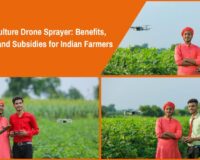Indian agriculture, which supports a vast portion of the country’s population, is undergoing a major transformation. With a shrinking rural workforce and increasing demand for efficiency, farmers are turning to technology for solutions. One of the most promising innovations is the agriculture drone sprayer. These unmanned aerial vehicles (UAVs) are no longer futuristic gadgets but practical tools that can revolutionize farming, boost productivity, and address the ongoing labor shortage.
Spraying 25 Acres with UAV-2 Agricluture Spraying Drones: Setup, Flight, & Fuel Mishap!
1. Precision and Efficiency
Drones are central to precision farming. They can be programmed to target specific sections of a field, applying pesticides, fertilizers, or water with exact accuracy. This minimizes wastage of expensive inputs and reduces environmental harm. Unlike manual or tractor-mounted spraying, which often results in uneven application, drones such as a drone spray machine ensure uniform distribution across crops. Studies show they can cut pesticide use by up to 40% and reduce water consumption by up to 90%.
2. Time and Labor Savings
One of the biggest advantages of drones is speed. A single agriculture spraying drone can spray an acre of land in just 5–10 minutes, a task that would take laborers hours or even days. This translates to a 30–50% reduction in labor costs. While drones reduce reliance on manual sprayers, they also generate new opportunities for skilled jobs such as drone pilots, technicians, and data analysts, offering career paths for rural youth.
3. Enhanced Safety
Manual spraying exposes farmers to hazardous chemicals, leading to serious health risks. By using drones, farmers avoid direct contact with pesticides, improving safety on the field and reducing long-term health issues.
Costs and Subsidies for Indian Farmers
Drone Costs
The cost of an Drone Machine varies by capacity and features. Entry-level models start at around ₹4.5 lakh, while advanced drones can cost up to ₹15 lakh. For instance, a 25 kg capacity drone—capable of covering 5–7 acres on a single charge—typically ranges between ₹7 lakh and ₹15 lakh.
Government Subsidies
Recognizing the potential of drones, the Indian government has introduced multiple subsidy schemes:
- Individual Farmers: Eligible for a 40–50% subsidy, capped at ₹4 lakh. Small/marginal farmers, women, SC/ST communities, and farmers from North Eastern States may receive up to ₹5 lakh.
- CHCs, FPOs, and Rural Entrepreneurs: Can avail of up to 75% subsidy, capped at ₹7.5 lakh, to purchase drones for rental services.
- ‘Namo Drone Didi’ Scheme: With a budget of ₹1261 crore, this program supports Women Self-Help Groups (SHGs). SHGs can get 80% of the drone’s cost (up to ₹8 lakh) for purchasing drones and offering rental services to farmers.
These subsidies greatly reduce costs, making drone adoption feasible for farmers and entrepreneurs alike.
Can Drone Machines Solve India’s Labour Crisis in Agriculture?
Using a drone sprayer requires proper training and planning. The process typically involves:
- Preparation – Fully charge batteries, fill the spray tank, and check GPS and sensors.
- Mission Planning – Define field boundaries, altitude, and spray patterns using specialized software. Many drones use RTK GPS for precise navigation.
- Flight Operation – The drone follows its programmed path, spraying crops while propellers push the liquid deep into the canopy. It returns automatically for refills or battery changes.
- Data Analysis – Advanced drones capture crop and soil data using multispectral or thermal cameras. This information helps farmers improve decision-making and maximize yields.
The government, along with private organizations, offers training programs to prepare farmers and youth for drone operation and maintenance. This not only solves labor shortages but also creates new, high-value employment opportunities in agriculture.
Conclusion
The agriculture drone sprayer is more than just a technological advancement—it’s a practical solution to India’s pressing agricultural challenges. By improving efficiency, saving costs, enhancing safety, and creating new jobs, drones represent the future of farming in India. With supportive government subsidies and training programs, the widespread adoption of drones could usher in a new era of sustainable and profitable agriculture.
Frequently Asked Questions
Q1. How much does an agricultural drone sprayer cost in India?
The price depends heavily on capacity, features, and technology. Small mapping drones can cost about ₹50,000–₹2,00,000, while entry-level spray drones (10-20 L payload) typically cost around ₹3–6 lakh. Larger industrial systems (30-40 L) may rise to ₹6–15 lakh or more.
Q2. Are there government subsidies or schemes for buying a drone spray machine?
Yes. There are several schemes that help reduce upfront cost for farmers:
- The Namo Drone Didi scheme: 80% subsidy on drone packages for Women SHGs, up to a maximum of ₹8 lakh.
- Under the Sub-Mission on Agricultural Mechanization (SMAM) and other government programs, subsidies can range from 40-80% depending on eligibility.
Q3. What are the legal / regulatory requirements for operating an agriculture spraying drone in India?
To operate legally, you’ll generally need:
- Registration of the drone with the Digital Sky platform, to get a Unique Identification Number (UIN)
- A Remote Pilot Certificate (RPC) issued from a training organisation approved by the DGCA (Directorate General of Civil Aviation)
- Use of DGCA-approved drone models if you want to access subsidies/licensing & comply with legal norms.




